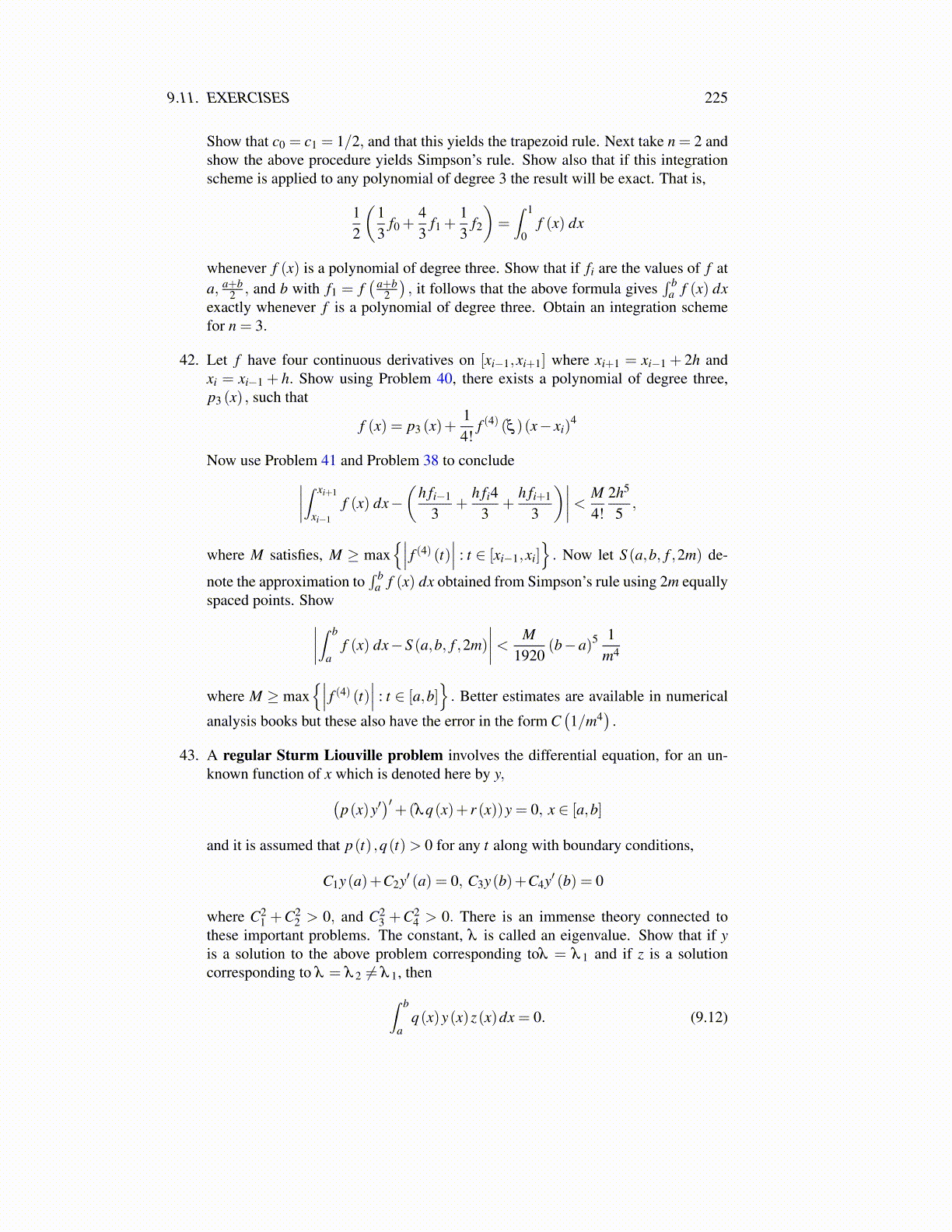
9.11. EXERCISES 225
Now use the chain rule and the fundamental theorem of calculus to find f ′ (x) . Thenchange the variable in the formula for f ′ (x) to make it an integral from 0 to 1 andshow f ′ (x)+g′ (x) = 0.Now this shows f (x)+g(x) is a constant. Show the constantis π/4 by assigning x = 0. Next take a limit as x→∞ to obtain the following formula
for the improper integral,∫
∞
0 e−t2dt,(∫
∞
0 e−t2dt)2
= π/4. In passing to the limit inthe integral for g as x→ ∞ you need to justify why that integral converges to 0. Todo this, argue the integrand converges uniformly to 0 for t ∈ [0,1] and then explainwhy this gives convergence of the integral. Thus
∫∞
0 e−t2dt =
√π/2.
50. To show you the power of Stirling’s formula, find whether the series ∑∞n=1
n!en
nn con-verges. The ratio test falls flat but you can try it if you like. Now explain why, if n islarge enough, n!≥ 1
2√
π√
2e−nnn+(1/2) ≡ c√
2e−nnn+(1/2).
51. The Riemann integral∫ b
a f (x)dt for integrator function F (t) = t is only defined if fis bounded. This problem discusses why this is the case. From the definition of theRiemann integral, there is a δ > 0 such that if ∥P∥< δ , then the Riemann sum SP ( f )
must satisfy∣∣∣SP ( f )−
∫ ba f dt
∣∣∣< 1. Pick such a partition P = {a = x0 < · · ·< xn = b}and say SP ( f ) = ∑
ni=1 f (ti)(xi− xi−1) . Suppose that f is unbounded on
[x j−1,x j
].
Then you can modify the points ti, keeping all the same except for t j ∈[x j−1,x j
]and
let this one be t̂ j where this is chosen so large that
∣∣ f (t̂ j)(x j− x j−1
)∣∣−(∣∣∣∣∣∑i̸= jf (ti)(xi− xi−1)
∣∣∣∣∣+∣∣∣∣∫ b
af dt∣∣∣∣+1
)> 100
Show this is a contradiction. Hence f must be bounded.
52. Does the above conclusion that f is bounded hold in case of an arbitrary RiemannStieltjes integral assuming the integrator function F is strictly increasing?
53. Use Theorem 9.9.1 and Lemma 9.9.2 to justify the following argument. Let f becontinuous on [a,b]× [c,d] . Let
F (x)≡∫ x
a
∫ d
cf (t,y)dydt−
∫ d
c
∫ x
af (t,y)dtdy.
Then F is continuous on [a,b] . Also F (a) = 0 and
F ′ (x) =∫ d
cf (x,y)dy−
∫ d
cf (x,y)dy = 0
and so F (b) = 0 so Fubini’s theorem holds.
54. Let {an} be a sequence of positive numbers such that limn→∞ nan = 0 and for all n ∈N, nan ≥ (n+1)an+1. Show that if this is so, it follows that the series, ∑
∞k=1 an sinnx
converges uniformly on R. This is a variation of a very interesting problem found inApostol’s book, [3]. Hint: Use the Dirichlet partial summation formula on ∑kak
sinkxk
and show the partial sums of ∑sinkx
k are bounded independent of x. To do this,you might argue the maximum value of the partial sums of this series occur when∑
nk=1 coskx = 0. Sum this series by considering the real part of the geometric series,
∑qk=1
(eix)k and then show the partial sums of ∑
sinkxk are Riemann sums for a certain
finite integral.